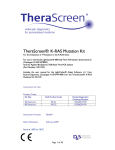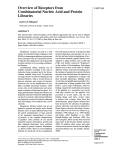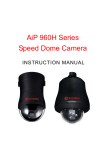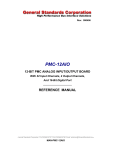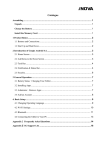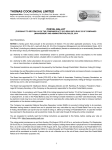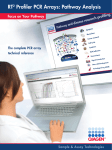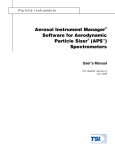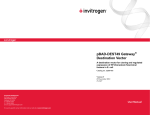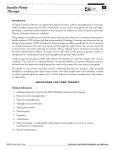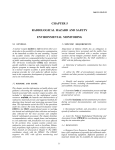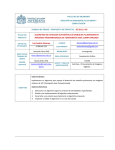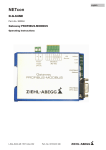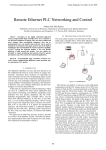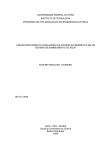Download CY-8090 Human TXNIP ELISA Kit
Transcript
Human TXNIP ELISA Kit User’s Manual For Research Use Only, Not for use in diagnostic procedures ELISA Kit for Measuring Human TXNIP On ly! CircuLex TM CircuLex Human TXNIP ELISA Kit ce Pu rp Intended Use................................................ 1 Storage......................................................... 1 Introduction.................................................. 2 Principle of the Assay.................................. 2-3 Materials Provided....................................... 3 Materials Required but not Provided........... 4 Precautions and Recommendations.............. 5 Sample Collection and Storage.....................6 Detailed Protocol.......................................... 7-8 Calculations..................................…............ 9 Measurement Range..................................... 9 Troubleshooting............................................ 10 Reagent Stability.......................................... 10 Sample Preparation...................................... 11-12 Assay Characteristics................................... 13-15 Example of Test Results................................16-19 References.................................................... 20 os e Cat# CY-8090 Intended Use The CycLex Research Product CircuLex Human TXNIP ELISA Kit is used for the quantitative measurement of human TXNIP in cell lysate, culture medium and serum. en This assay kit is for research use only and not for use in diagnostic or therapeutic procedures. Storage rR ef er • Upon receipt store all components at 4°C. • Don’t expose reagents to excessive light. Fo Cat#: CY-8090 1 Version#: 150601 Human TXNIP ELISA Kit User’s Manual For Research Use Only, Not for use in diagnostic procedures On ly! CircuLex TM Introduction os e Thioredoxin-interacting protein (TXNIP), the endogenous inhibitor of thioredoxin also known as vitamin D3 up-regulated protein-1 (1, 2) or thioredoxin-binding protein-2 (3), inhibits thioredoxin antioxidative function by binding to its active-site thiols (3, 4). It was also demonstrated that TXNIP plays a crucial role for caspase-1 activation caused by high glucose treatment in murine β-cells by direct interaction with the NLRP3-inflammasome (5). TXNIP-dependent inflammasome activation appears to be specific for NLRP3, as TXNIP deficiency did not affect the activity of other inflammasomes, e.g., NLRC4 and AIM2 (5). TXNIP levels are elevated in subjects with type 2 diabetes mellitus (6), and its expression is induced by glucose-6-phosphate through an intracellular transcriptional complex of MondoA and Max-like protein X (7). TXNIP is induced by various types of cellular stress, including oxidative stress, UV irradiation, heat shock and apoptotic signaling (8), and is often suppressed in various human tumors (9, 10). Overexpression of TXNIP inhibits proliferation via cell-cycle arrest and promotes apoptosis (1, 4). Principle of the Assay rR ef er en ce Pu rp The CycLex Research Product CircuLex Human TXNIP ELISA Kit employs the quantitative sandwich enzyme immunoassay technique. An antibody specific for human TXNIP is pre-coated onto a microplate. Standards and samples are pipetted into the wells and the immobilized antibody binds any human TXNIP present. After washing away any unbound substances, an HRP conjugated antibody specific for human TXNIP is added to the wells. Following a wash to remove any unbound antibody HRP conjugate, the remaining conjugate is allowed to react with the substrate H2O2-tetramethylbenzidine. The reaction is stopped by addition of acidic solution and absorbance of the resulting yellow product is measured at 450 nm. The absorbance is proportional to the concentration of human TXNIP. A standard curve is constructed by plotting absorbance values versus human TXNIP concentrations of calibrators, and concentrations of unknown samples are determined using this standard curve. Fo Cat#: CY-8090 2 Version#: 150601 Human TXNIP ELISA Kit User’s Manual For Research Use Only, Not for use in diagnostic procedures Summary of Procedure Add 100 µL of diluted samples to the wells Incubate for 1.5 hours at room temp. Wash the wells On ly! CircuLex TM Add 100 µL of HRP conjugated anti-human TXNIP antibody Wash the wells Add 100 µL of Substrate Reagent Pu rp Add 100 µL of Stop Solution os e Incubate for 1.5 hours at room temp. Measure absorbance at 450 nm Materials Provided All samples and standards should be assayed in duplicate. The following components are supplied and are sufficient for the one 96-well microplate kit. ce Microplate: One microplate supplied ready to use, with 96 wells (12 strips of 8-wells) in a foil, zip-lock bag with a desiccant pack. Wells are coated with anti-human TXNIP antibody as a capture antibody. 10X Wash Buffer: One bottle containing 100 mL of 10X buffer containing Tween®-20 en Dilution Buffer: One bottle containing 50 mL of 1X buffer; use for reconstitution of Human TXNIP Standard and sample dilution. Ready to use. Human TXNIP Standard: One vial containing 200 ng of lyophilized recombinant human TXNIP er HRP conjugated Detection Antibody: One bottle containing 12 mL of HRP (horseradish peroxidase) conjugated anti-human TXNIP antibody. Ready to use. ef Substrate Reagent: One bottle containing 20 mL of the chromogenic substrate, tetra-methylbenzidine (TMB). Ready to use. rR Stop Solution: One bottle containing 20 mL of 1 N H2SO4. Ready to use. Fo Cat#: CY-8090 3 Version#: 150601 Human TXNIP ELISA Kit User’s Manual For Research Use Only, Not for use in diagnostic procedures On ly! CircuLex TM Materials Required but not Provided • Pipettors: 2-20 µL, 20-200 µL and 200-1000 µL precision pipettors with disposable tips • Precision repeating pipettor • Orbital microplate shaker • Microcentrifuge and tubes for sample preparation os e • Vortex mixer • Microplate washer: optional (Manual washing is possible but not preferable) • Plate reader: capable of measuring absorbance in 96-well plates at dual wavelengths of 450/540 nm. Dual wavelengths of 450/550 or 450/595 nm can also be used. The plate can also be read at a single wavelength of 450 nm, which will give a somewhat higher reading. • 500 or 1000 mL graduated cylinder • Reagent reservoirs • Deionized water of the highest quality rR ef er en ce • Disposable paper towels Pu rp • Software package facilitating data generation and analysis: optional Fo Cat#: CY-8090 4 Version#: 150601 Human TXNIP ELISA Kit User’s Manual For Research Use Only, Not for use in diagnostic procedures Precautions and Recommendations • Allow all the components to come to room temperature before use. On ly! CircuLex TM • All microplate strips that are not immediately required should be returned to the zip-lock pouch, which must be carefully resealed to avoid moisture absorption. • Do not use kit components beyond the indicated kit expiration date. os e • Use only the microtiter wells provided with the kit. • Rinse all detergent residues from glassware. • Use deionized water of the highest quality. • Do not mix reagents from different kits. Pu rp • The buffers and reagents in this kit may contain preservatives or other chemicals. Care should be taken to avoid direct contact with these reagents. • Do not mouth pipette or ingest any of the reagents. • Do not smoke, eat, or drink when performing the assay or in areas where samples or reagents are handled. • Dispose of tetra-methylbenzidine (TMB) containing solutions in compliance with local regulations. • Avoid contact with the acidic Stop Solution and Substrate Solution, which contains hydrogen peroxide. ce • Wear gloves and eye protection when handling immunodiagnostic materials and samples of human origin, and these reagents. In case of contact with the Stop Solution and the Substrate Solution, wash skin thoroughly with water and seek medical attention, when necessary. en • Biological samples may be contaminated with infectious agents. Do not ingest, expose to open wounds or breathe aerosols. Wear protective gloves and dispose of biological samples properly. rR ef er • CAUTION: Sulfuric Acid is a strong acid. Wear disposable gloves and eye protection when handling Stop Solution. Fo Cat#: CY-8090 5 Version#: 150601 Human TXNIP ELISA Kit User’s Manual For Research Use Only, Not for use in diagnostic procedures On ly! CircuLex TM Sample Collection and Storage Cell lysates: Prepare cell lysates. Assay immediately or store the samples on ice for a few hours before assaying. Aliquots of the samples may also be stored at below -70°C for extended periods of time. Avoid repeated freeze-thaw cycles. os e Serum: Use a serum separator tube and allow samples to clot for 60 ± 30 minutes. Centrifuge the samples at 4°C for 10 minutes at 1,000 x g. Remove serum and assay immediately or store samples on ice for up to 6 hours before assaying. Aliquots of serum may also be stored at below -70°C for extended periods of time. Avoid repeated freeze-thaw cycles. Plasma: Collect plasma using EDTA-Na2 as the anticoagulant. If possible, collect the plasma into a mixture of EDTA-Na2 and Futhan5 to stabilize the sample against spontaneous in vitro complement activation. Immediately centrifuge samples at 4°C for 15 minutes at 1,000 x g. Assay immediately or store samples on ice for up to 6 hours before assaying. Aliquots of plasma may also be stored at below -70°C for extended periods of time. Avoid repeated freeze-thaw cycles. Pu rp Note: Citrate plasma has not been validated for use in this assay. rR ef er en ce Other biological samples: Remove any particulates by centrifugation and assay immediately or aliquot and store samples at below -70°C. Avoid repeated freeze-thaw cycles. Fo Cat#: CY-8090 6 Version#: 150601 Human TXNIP ELISA Kit User’s Manual For Research Use Only, Not for use in diagnostic procedures On ly! CircuLex TM Detailed Protocol The CycLex Research Product CircuLex Human TXNIP ELISA Kit is provided with removable strips of wells so the assay can be carried out on separate occasions using only the number of strips required for the particular determination. Since experimental conditions may vary, an aliquot of the human TXNIP Standard within the kit, should be included in each assay as a calibrator. Disposable pipette tips and reagent troughs should be used for all liquid transfers to avoid cross-contamination of reagents or samples. Preparation of Working Solutions os e All reagents need to be brought to room temperature prior to the assay. Assay reagents are supplied ready-to-use, with the exception of 10X Wash Buffer and Human TXNIP Standard. 1. Prepare a working solution of Wash Buffer by adding 100 mL of the 10X Wash Buffer to 900 mL of deionized (distilled) water. Mix well. Store at 4°C for two weeks or -20°C for long-term storage. Pu rp 2. Reconstitute Human TXNIP Standard with 1.0 mL of Dilution Buffer. The concentration of the TXNIP in vial should be 200 ng/mL, which is referred as a 10X Master Standard of TXNIP. Prepare Standard Solutions as follows: Use the 10X Master Standard to produce a dilution series (below). Mix each tube thoroughly before the next transfer. The 1,200 pg/mL standard (Std.1) serves as the highest standard. The Dilution Buffer serves as the zero standard (Blank). ce en Master Standard Std.1 Std.2 Std.3 Std.4 Std.5 Std.6 Std.7 Blank Volume of Standard 100 µL of 10X Master Standard (200 ng/mL) 60 µL of Master Standard (20 ng/mL) 300 µL of Std. 1 (1,200 pg/ml) 300 µL of Std. 2 (600 pg/ml) 300 µL of Std. 3 (300 pg/ml) 300 µL of Std. 4 (150 pg/ml) 300 µL of Std. 5 (75 pg/ml) 300 µL of Std. 6 (37.5 pg/ml) - Dilution Buffer 900 µL 940 µL 300 µL 300 µL 300 µL 300 µL 300 µL 300 µL 300 µL Concentration 20 ng/mL 1,200 pg/mL 600 pg/mL 300 pg/mL 150 pg/mL 75 pg/mL 37.5 pg/mL 18.8 pg/mL 0 pg/mL er Note: Do not use a Repeating pipette. Change tips for every dilution. Wet tip with Dilution Buffer before dispensing. Unused portions of Master Standard should be aliquoted and stored at below -70°C immediately. Avoid multiple freeze and thaw cycles. Sample Preparation ef • Serum and plasma samples require a 50- to 100-fold dilution. rR • Other biological samples and cell lysate require neat to appropriate dilution. Fo Cat#: CY-8090 7 Version#: 150601 Human TXNIP ELISA Kit User’s Manual For Research Use Only, Not for use in diagnostic procedures Standard Assay Procedure for Human TXNIP On ly! CircuLex TM 1. Remove the appropriate number of microtiter wells from the foil pouch and place them into the well holder. Return any unused wells to the foil pouch, refold, seal with tape and store at 4°C. 2. Dilute serum sample with Dilution Buffer. (See “Sample Preparation” above.) 3. Pipette 100 µL of Standard Solutions (Std1-Std7, Blank) and the diluted samples in duplicates, into the appropriate wells. os e 4. Incubate the wells at room temperature (ca.25°C) for 1.5 hours, shaking at ca. 300 rpm on an orbital microplate shaker. 5. Wash 4-times by filling each well with Wash Buffer (350 µL) using a squirt bottle, multi-channel pipette, manifold dispenser or microplate washer. 6. Add 100 µL of HRP conjugated Detection Antibody into each well. Pu rp 7. Incubate the wells at room temperature (ca.25°C) for 1.5 hours, shaking at ca. 300 rpm on an orbital microplate shaker. 8. Wash 4-times by filling each well with Wash Buffer (350 µL) using a squirt bottle, multi-channel pipette, manifold dispenser or microplate washer. 9. Add 100 µL of Substrate Reagent to each well. Avoid exposing the microtiter plate to direct sunlight. Covering the wells with e.g. aluminum foil is recommended. Return Substrate Reagent to 4°C immediately after the necessary volume is removed. ce 10. Incubate the wells at room temperature (ca.25°C) for 10-20 minutes, shaking at ca. 300 rpm on an orbital microplate shaker. The incubation time may be extended up to 30 minutes if the reaction temperature is below than 20°C. 11. Add 100 µL of Stop Solution to each well in the same order as the previously added Substrate Reagent. en 12. Measure absorbance in each well using a spectrophotometric microplate reader at dual wavelengths of 450/540 nm. Dual wavelengths of 450/550 or 450/595 nm can also be used. Read the microplate at 450 nm if only a single wavelength can be used. Wells must be read within 30 minutes of adding the Stop Solution. rR ef er Note-1: Complete removal of liquid at each step is essential to good performance. After the last wash, remove any remaining Wash Buffer by aspirating or decanting. Invert the plate and blot it against clean paper towels. Note-2: Reliable standard curves are obtained when either O.D. values do not exceed 0.25 units for the blank (zero concentration), or 3.0 units for the highest standard concentration. The plate should be monitored at 5-minute intervals for approximately 30 minutes. Note-3: If the microplate reader is not capable of reading absorbance greater than the absorbance of the highest standard, perform a second reading at 405 nm. A new standard curve, constructed using the values measured at 405 nm, is used to determine TXNIP concentration of off-scale samples. The readings at 405 nm should not replace the on-scale readings at 450 nm. Fo Cat#: CY-8090 8 Version#: 150601 Human TXNIP ELISA Kit User’s Manual For Research Use Only, Not for use in diagnostic procedures On ly! CircuLex TM Calculations os e Average the duplicate readings for each Standard Solution, control, and sample and subtract the average zero standard optical density. Plot the optical density for the standards versus the concentration of the standards and draw the best curve. The data can be linearized by using log/log paper and regression analysis may be applied to the log transformation. To determine the human TXNIP concentration of each sample, first find the absorbance value on the y-axis and extend a horizontal line to the standard curve. At the point of intersection, extend a vertical line to the x-axis and read the corresponding human TXNIP concentration. If the samples have been diluted, the concentration read from the standard curve must be multiplied by the dilution factor. 1. The dose-response curve of this assay fits best to a sigmoidal four-parameter logistic equation. The results of unknown samples can be calculated with any computer program having a four-parameter logistic function. It is important to make an appropriate mathematical adjustment to accommodate for the dilution factor. Pu rp 2. Most microtiter plate readers perform automatic calculations of analyte concentration. The calibration curve is constructed by plotting the absorbance (Y) of calibrators versus log of the known concentration (X) of calibrators, using the four-parameter function. Alternatively, the logit log function can be used to linearize the calibration curve (i.e. logit of absorbance (Y) is plotted versus log of the known concentration (X) of calibrators). Measurement Range rR ef er en ce The measurement range is 1,200 pg/mL to 18.8 pg/mL. Any sample reading higher than the highest standard should be diluted with Dilution Buffer in higher dilution and re-assayed. Dilution factors need to be taken into consideration in calculating the human TXNIP concentration. Fo Cat#: CY-8090 9 Version#: 150601 Human TXNIP ELISA Kit User’s Manual For Research Use Only, Not for use in diagnostic procedures On ly! CircuLex TM Troubleshooting 1. The Standard Solutions should be run in duplicate, using the protocol described in the Detailed Protocol. Incubation times or temperatures significantly different from those specified may give erroneous results. 2. Poor duplicates, accompanied by elevated values for wells containing no sample, indicate insufficient washing. If all instructions in the Detailed Protocol were followed accurately, such results indicate a need for washer maintenance. os e 3. Overall low signal may indicate that desiccation of the plate has occurred between the final wash and addition of Substrate Reagent. Do not allow the plate to dry out. Add Substrate Reagent immediately after wash. Reagent Stability rR ef er en ce Pu rp All of the reagents included in the CycLex Research Product CircuLex Human TXNIP ELISA Kit have been tested for stability. Reagents should not be used beyond the stated expiration date. Upon receipt, kit reagents should be stored at 4°C, except the reconstituted TXNIP Standard must be stored at below -70°C. The Microplate should be stored in the original foil bag sealed by the zip lock and containing a desiccant pack. Fo Cat#: CY-8090 10 Version#: 150601 Human TXNIP ELISA Kit User’s Manual For Research Use Only, Not for use in diagnostic procedures On ly! CircuLex TM Sample Preparation Several extraction methods can be used for measurement cellular total TXNIP. The following protocol has been shown to work with a number of different cell lines and is provided as an example of suitable methods. It is strongly advised that the user always performs an initial experiment to determine the proper dilution to be used in subsequent experiments. This needs not be any more than a single time point assay using serial dilutions of the cell lysate. One eight well strip of the substrate plate should be sufficient for this initial experiment. All steps of cell lysate preparation should be performed at 4°C and recovered cell lysates should be kept at below -70°C. os e Preparation of Cell Lysate A. Preparation of cell lysis buffer 20 mM Tris HCl, pH 7.5, 250 mM NaCl, 10 % glycerol, 0.1 % NP-40, 5 mM EDTA, 1 mM EGTA, 0.2 mM PMSF, 1 µg/mL pepstatin, 0.5 µg/mL leupeptin, 0.2 mM DTT Pu rp B. Preparation of poly-L-lysine (PLL) coated plate Coat wells of a 96-well plate with 100 uL/well of 25 µg/mL poly-L-lysine in PBS for 4-12 hours at 37°C. Subsequently wash the wells three times with PBS. C. Treatment of cells 1. Plate adherent cells in the PLL-coated 96-well plate at around 1 x 105 cells/well. 2. Incubate the plate at 37°C for 7-12 hours in CO2 incubator. 3. Add an appropriate amount of a test compound or glucose and a vehicle for a test compound to each well. ce 5. Incubate the plate at 37°C for appropriate time in CO2 incubator. D. Cell extraction en Note: This protocol has been successfully applied to HeLa cell line. Users should optimize the cell extraction procedure for their own applications. er 1. Wash cells three times with ice-cold PBS. Remove any remaining PBS by decanting. Invert the plate and blot it against clean paper towels. At this point the cells in the plate can be frozen at below -70°C and lysed at a later date. 2. Lyse the cells by adding 0.1 mL* of the cell lysis buffer for 60-90 minutes at 4°C, with rotating at ca. 300 rpm by an orbital microplate shaker. ef * To get a rough idea you could adjust the cell concentration to around 1-2 x 106 cells/mL in the cell lysis buffer. Resulting protein concentration of the HeLa cell lysate should be 0.3-0.4 mg/mL using this procedure. rR * The appropriate volume of the cell lysis buffer depends on the cell line, the cell number and the amount of total TXNIP. For example, 1-2 x 105 HeLa cells can be lysed in 0.1 mL of the cell lysis buffer. Fo Cat#: CY-8090 11 Version#: 150601 Human TXNIP ELISA Kit User’s Manual For Research Use Only, Not for use in diagnostic procedures On ly! CircuLex TM 3. Centrifuge at 3,500 rpm for 15 minutes at 4°C using a microplate bucket. (Or transfer the cell lysates to microcentrifuge tubes and centrifuge at 15,000 rpm for 5 minutes at 4°C.) 4. Transfer the clear cell lysates to a new 96-well plate or clean microcentrifuge tubes. Dilute these cell lysates 10 times with Dilution Buffer. 100 µL of these diluted cell lysates are ready for assay. Go to the section “Standard Assay Procedure for Human TXNIP” at page 8. Typical data using this protocol are shown in Fig. 3 and Fig. 6 (page 17 and 18) os e The cell lysates can be stored at below -70°C. Avoid multiple freeze/thaw cycles. After thaw the cell lysates, centrifuge at 15,000 rpm for 5 minutes at 4°C again since the cell lysates should be clear of any sediments or particulate matter. rR ef er en ce Pu rp NOTE: THE ABOVE PROCEDURES ARE INTENDED ONLY AS A GUIDELINE. THE OPTIMAL EXPERIMENTAL CONDITIONS WILL VARY DEPENDING ON THE PARAMETERS BEING INVESTIGATED, AND MUST BE DETERMINED BY THE INDIVIDUAL USER. NO WARRANTY OR GUARANTEE OF PERFORMANCE USING THESE PROCEDURES IS MADE OR IMPLIED. Fo Cat#: CY-8090 12 Version#: 150601 Human TXNIP ELISA Kit User’s Manual For Research Use Only, Not for use in diagnostic procedures On ly! CircuLex TM Assay Characteristics 1. Sensitivity The limit of detection (defined as such a concentration of human TXNIP giving absorbance higher than mean absorbance of blank* plus three standard deviations of the absorbance of blank: A blank + 3SD blank) is calculated to be better than 9.41 pg/mL of sample based on eighteen assays. * Dilution Buffer is pipetted into blank wells. TXNIP Standard Curve Pu rp 2.5 2.0 A450 1.5 ce 1.0 en 0.5 0.0 os e Typical Standard Curve 200 400 600 800 1,000 1,200 TXNIP (pg/ml) rR ef er 0 Fo Cat#: CY-8090 13 Version#: 150601 Human TXNIP ELISA Kit User’s Manual For Research Use Only, Not for use in diagnostic procedures 2. Precision On ly! CircuLex TM Intra-assay Precision (Precision within an assay) Three samples of known concentration were tested seven times on one plate to assess intra-assay precision. • Intra-assay (Within-Run, n=7) CV=3.5-8.8 % Human TXNIP concentration (ng/mg total protein) os e Sample 1 Sample 2 Sample 3 1.1 3.1 4.9 1.2 3.1 4.4 1.2 3.2 4.8 1.3 3.1 4.8 1.1 2.9 4.9 1.0 3.0 4.7 1.0 3.3 4.9 1.4 3.3 5.7 1.1 2.9 5.1 1.2 3.1 5.6 0.1 0.1 0.2 8.8 3.5 3.9 Pu rp No. 1 2 3 4 5 6 7 max. min. mean SD CV(%) ce Inter-assay Precision (Precision between assays) Three samples of known concentration were tested in three separate assays to assess inter-assay precision. • Inter-assay (Run-to-Run, n=3) CV=1.6 – 4.3 % en Human TXNIP concentration (ng/mg total protein) rR ef er Assay 1 2 3 max. min. mean SD CV(%) Fo Cat#: CY-8090 Sample 1 Sample 2 Sample 3 1.2 3.1 5.7 1.2 3.1 5.8 1.3 3.0 5.3 1.3 3.1 5.8 1.2 3.0 5.3 1.2 3.1 5.6 0.0 0.0 0.2 3.4 1.6 4.3 14 Version#: 150601 On ly! CircuLex Human TXNIP ELISA Kit User’s Manual For Research Use Only, Not for use in diagnostic procedures TM 3. Linearity To assess the linearity of the assay, samples containing and/or spiked with high concentrations of human TXNIP were serially diluted with Dilution Buffer to produce samples with values within the dynamic range of the assay. Line arity 5 os e 3 2 1 0 1 2 3 Sample Dilution Ratio (/4) 4 rR ef er en ce 0 Pu rp TXNIP (ng/mg total protein) 4 Fo Cat#: CY-8090 15 Version#: 150601 Human TXNIP ELISA Kit User’s Manual For Research Use Only, Not for use in diagnostic procedures On ly! CircuLex TM Example of Test Results Fig.1. Glucose-dose dependent production of TXNIP in HeLa cells after glucose treatment for 24 hours, cultured in 24-well plate TXNIP le ve l in He La ce ll lys ate afte r Glucose tre atme nt for 24hrs. os e 3 2 1 0 0 5 Pu rp TXNIP conc. (ng/mg total protein) 4 10 15 20 25 Glucose conc. (mM ) Fig.2. NaN3-dose dependent inhibition of TXNIP production in HeLa cells after NaN3 treatment for 24 hours, cultured in 24-well plate ce TXNIP le ve l in He La ce ll lysate afte r NaN 3 tre atme nt for 24hrs. en TXNIP conc. (ng/mg total protein) 10 8 rR ef er 6 Fo Cat#: CY-8090 4 2 0 0.00 0.02 0.04 0.06 0.08 0.10 NaN 3 conc. (%) 16 Version#: 150601 Human TXNIP ELISA Kit User’s Manual For Research Use Only, Not for use in diagnostic procedures On ly! CircuLex TM Fig.3. Glucose-dose dependent production of TXNIP in HeLa cells after glucose treatment for 24 hours, cultured in 96-well plate TXNIP le ve l in He La ce ll lysate afte r Glucose tre atme nt for 24hrs. os e 4 3 2 1 0 0 5 Pu rp TXNIP conc. (ng/mg total protein) 5 10 15 20 25 Glucos e conc. (mM ) Fig.4. NaN3-dose dependent inhibition of TXNIP production in HeLa cells after NaN3 treatment for 24 hours, cultured in 96-well plate 6 en TXNIP conc. (ng/mg total protein) 7 ce TXNIP le ve l in He La ce ll lysate afte r NaN 3 tre atme nt for 24hrs . 5 4 rR ef er 3 Fo Cat#: CY-8090 2 1 0 0.00 0.02 0.04 0.06 0.08 0.10 NaN 3 conc. (%) 17 Version#: 150601 Human TXNIP ELISA Kit User’s Manual For Research Use Only, Not for use in diagnostic procedures On ly! CircuLex TM Fig.5. Concentrations of human TXNIP in HeLa cell lysate after addition of 25 mM glucose at indicated times, cultured in 96-well plate Time cours e of TXNIP productin in He La ce ll lys ate afte r 25mM Glucos e tre atme nt os e 3 2 1 Pu rp TXNIP conc. (ng/mg total protein) 4 0 0 1 2 4 6 8 Time cours e (hr.) 9 24 Fig.6. Concentrations of human TXNIP in HeLa cell lysate after depletion of glucose at indicated times, cultured in 96-well plate ce Time cours e of TXNIP productin in He La ce ll lysate afte r 0.01% NaN 3 tre atme nt en TXNIP conc. (ng/mg total protein) 5 4 rR ef er 3 Fo Cat#: CY-8090 2 1 0 0 1 2 4 6 8 9 24 Time cours e (hr.) 18 Version#: 150601 Human TXNIP ELISA Kit User’s Manual For Research Use Only, Not for use in diagnostic procedures Fig.7. Human TXNIP levels in 40 sera of healthy volunteers On ly! CircuLex TM Human TXNIP concentration (n = 40) 12 Max Min Mean 11.0 0.2 2.0 os e 10 Pu rp Serum TXNIP conc. (ng/ml) 8 6 en ce 4 er 2 rR ef 0 Fo Cat#: CY-8090 19 Version#: 150601 Human TXNIP ELISA Kit User’s Manual For Research Use Only, Not for use in diagnostic procedures On ly! CircuLex TM References 1. Wang, Y., De Keulenaer, G. W., and Lee, R. T. (2002) J. Biol. Chem. 277: 26496-26500 2. Schulze, P. C., De Keulenaer, G. W., Yoshioka, J., Kassik, K. A., and Lee, R. T. (2002) Circ. Res. 91: 689-695 3. Nishiyama, A., Matsui, M., Iwata, S., Hirota, K., Masutani, H., Nakamura, H., Takagi, Y., Sono, H., Gon, Y., and Yodoi, J. (1999) J. Biol. Chem. 274: 21645-21650 os e 4. Junn, E., Han, S. H., Im, J. Y., Yang, Y., Cho, E. W., Um, H. D., Kim, D. K., Lee, K. W., Han, P. L., Rhee, S. G., and Choi, I. (2000) J. Immunol. 164: 6287- 6295 5. Zhou R, Tardivel A, Thorens B, Choi I, Tschopp J. (2010) Nat Immunol. 11: 136-140 6. Parikh H, Carlsson E, Chutkow WA, et al. (2007) PLoS Med. 4: e158 Pu rp 7. Stoltzman CA, Peterson CW, Breen KT, Muoio DM, Billin AN, Ayer DE. (2008) Proc Natl Acad Sci USA. 105: 6912-6917 8. Fidler IJ, Radinsky R. (1996) J Natl Cancer Inst 88: 1700-1703. 9. Nakamura H, Masutani H, Yodoi J. (2006) Semin Cancer Biol 16: 444-451. PRODUCED BY er en CycLex Co., Ltd. 1063-103 Terasawaoka Ina, Nagano 396-0002 Japan Fax: +81-265-76-7618 e-mail: [email protected] URL: http://www.cyclex.co.jp ce 10. Goldberg SF, Miele ME, Hatta N, Takata M, Paquette-Straub C, Freedman LP et al. (2003) Cancer Res 63: 432-440. rR ef CycLex/CircuLex products are supplied for research use only. CycLex/CircuLex products and components thereof may not be resold, modified for resale, or used to manufacture commercial products without prior written approval from CycLex Co., Ltd.. To inquire about licensing for such commercial use, please contact us via email. Fo Cat#: CY-8090 20 Version#: 150601




















